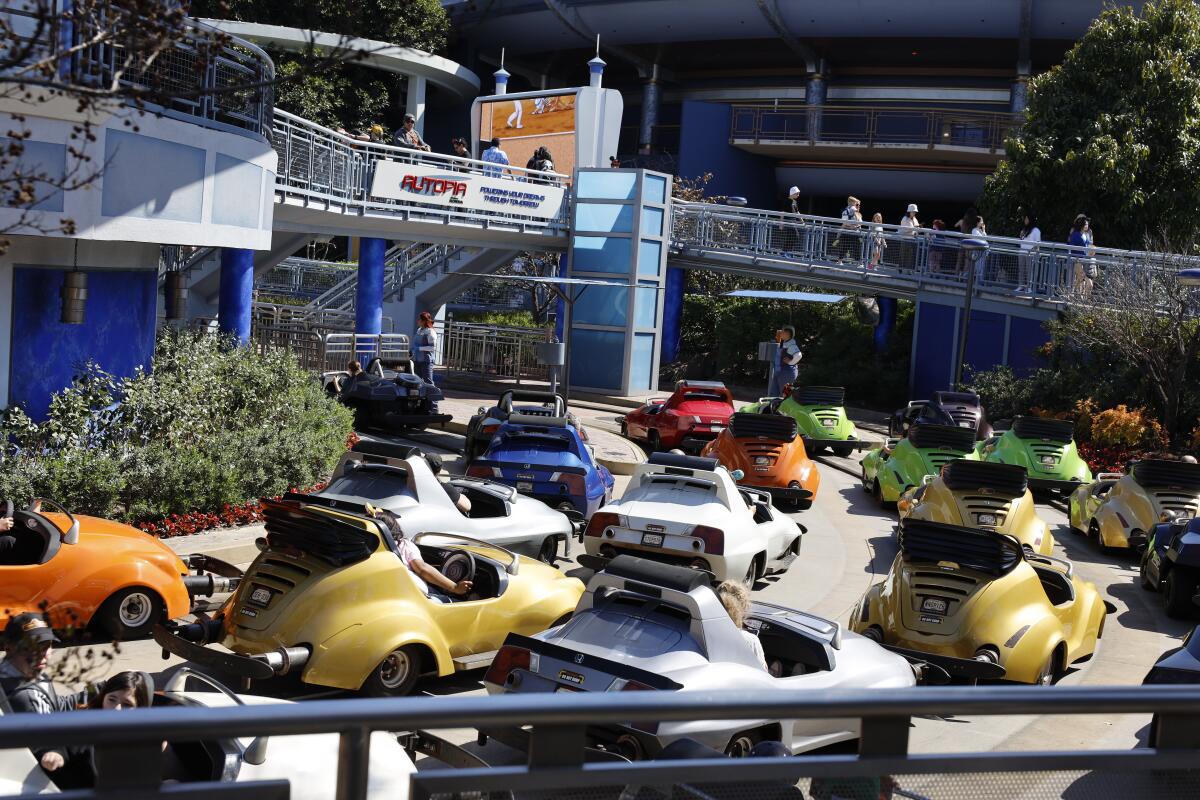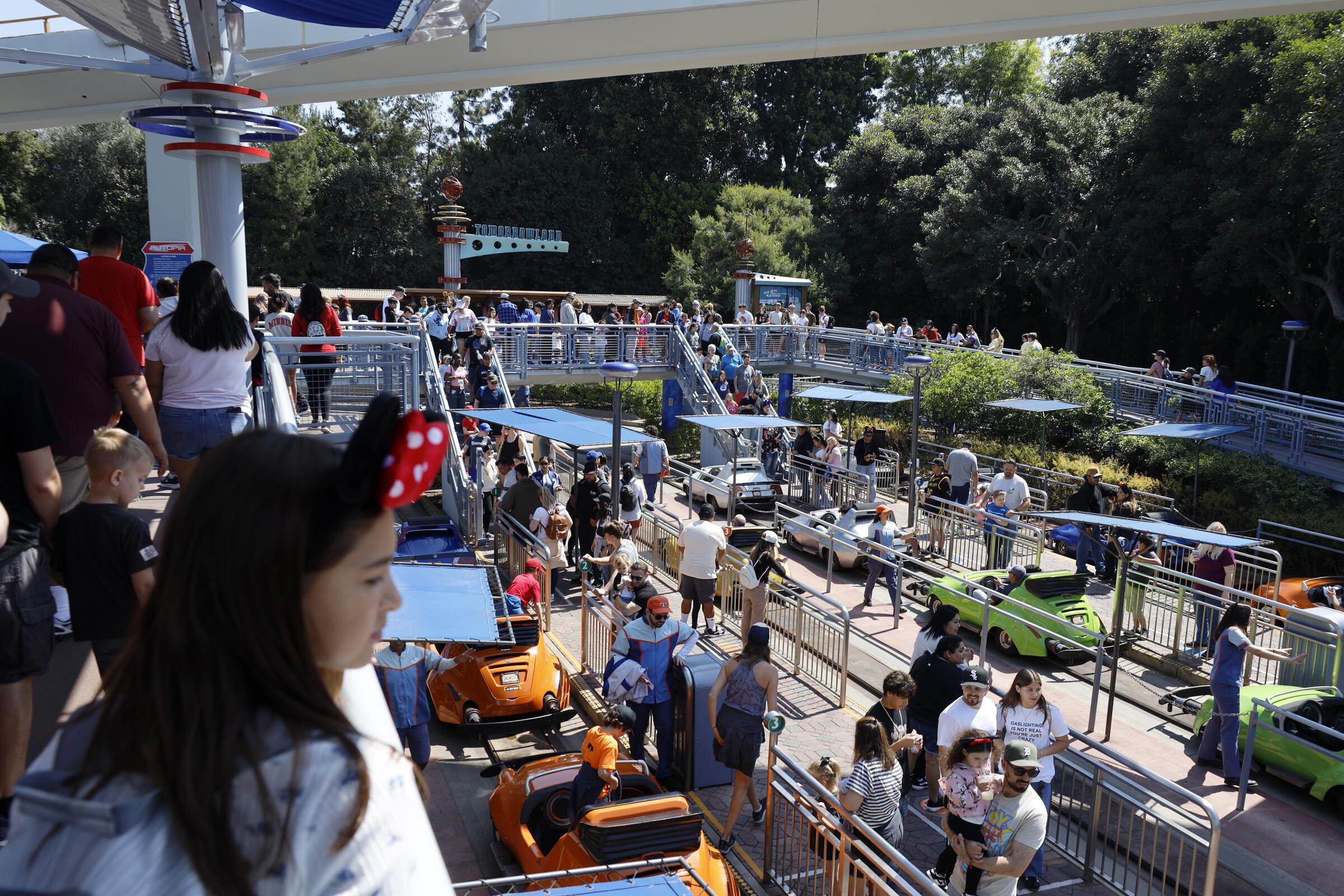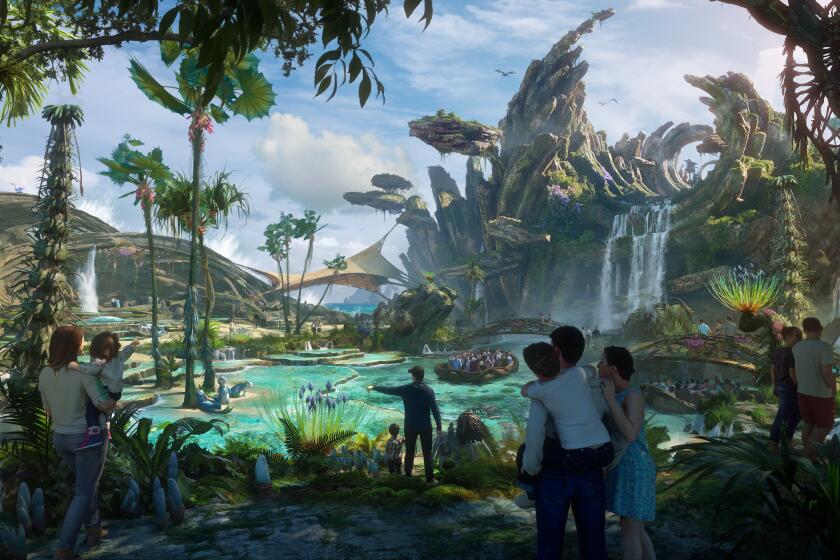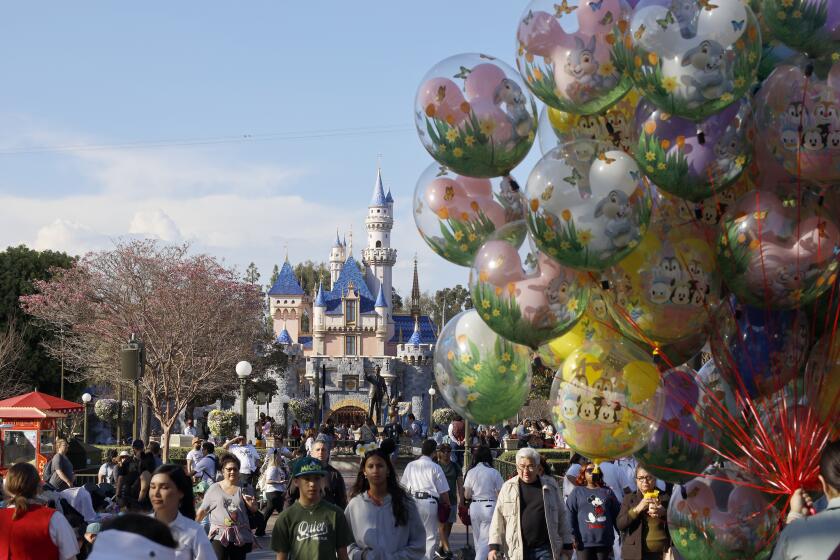Sammy Roth is the climate columnist for the Los Angeles Times. He writes the twice-weekly Boiling Point newsletter and focuses on clean energy solutions. He previously reported for the Desert Sun and USA Today, where he covered renewable energy and public lands. He grew up in Westwood and would very much like to see the Dodgers win the World Series again.
- Share via
1
When the Walt Disney Co. announced earlier this month that it would at long last ditch the smog-spewing gasoline engines at its beloved Autopia attraction in Anaheim, the company left a few key details to the imagination.
Would the new ride vehicles be purely electric? Or would they be hybrids that still burned some climate-wrecking, oil-based fuel? And how long would it take for Walt Disney’s creative and engineering heirs to make the long-overdue switch?
After I wrote a story breaking the news about the company’s plans, a coalition of electric vehicle activists launched a campaign to pressure Disney to commit to electric vehicles — not hybrids — and to phase out gasoline within two years.
On Thursday, those activists won.
Your guide to our clean energy future
Get our Boiling Point newsletter for the latest on the power sector, water wars and more — and what they mean for California.
You may occasionally receive promotional content from the Los Angeles Times.
In a written statement, Disneyland spokesperson Jessica Good confirmed to The Times that electrification “means fully electric — it does not mean hybrid or any other version of a gasoline combustion engine.” She added that the theme park “will no longer be using the current engines within the next 30 months.”
That means by fall 2026, Disneyland guests will no longer have to worry about breathing lung-damaging exhaust as they wait in line for Autopia — and park employees won’t have spend hours-long shifts inhaling those fumes as they work the ride.
It’s not yet clear when the newly electrified Autopia will reopen.
“Reimagining an attraction does take time, so we don’t have a reopening date at this time,” Good said.
With the approval of DisneylandForward, new attractions and adventures will be coming to Disneyland. Here’s what’s been teased by Disney officials so far.
Zan Dubin, the electric vehicle advocate leading the pressure campaign, was thrilled when she heard Thursday’s news. She called it a “huge victory” and a powerful reminder that climate activism works.
“All it takes for bad stuff to keep happening is for good people to do nothing,” she said, paraphrasing Abraham Lincoln. “And we refuse to stand by and do nothing.”
Dubin had been planning to lead a rally outside Walt Disney Studios in Burbank on Sunday, to urge the company to do better on Autopia. She’s told me she’s moving forward with the event, although she said it will now be more of a celebration.
“We are thrilled,” she said.
The stories that Disney tells at its theme parks — and on its streaming services, cruise ships and other platforms — are far more than entertainment. They play a powerful role in shaping how we understand our world and ourselves. That’s why the company’s decision to close Disneyland’s Splash Mountain ride — which was based on a racist film — and its increasing embrace of LGBTQ+ characters in its films have become such political flash points. The opponents of progress know that these choices matter.
If you care about climate progress, you should care about Autopia.

(Allen J. Schaben / Los Angeles Times)
When the ride opened in 1955 as a centerpiece of Walt Disney’s Tomorrowland, it helped cement in the American consciousness the idea that gas-guzzling cars — and sprawling freeways — were the promise of the future. Within a year, President Eisenhower had signed the bill that would create the Interstate Highway System as we know it today.
Nearly 70 years later, cars, trucks and other modes of transportation are the nation’s largest source of heat-trapping emissions — emissions that have fueled record global temperatures for 10 straight months, resulting in deadlier heat waves, fires and storms. Fossil fuel combustion also produces regular old air pollution that researchers say kills millions of people each year.
Switching from gasoline engines to electric cars alone won’t solve all of our environmental and public health problems.
Mining to supply lithium for lithium-ion electric car batteries can be environmentally destructive in some places. Freeways have historically been built through low-income communities of color, tearing apart vibrant neighborhoods. The more we can rebuild our cities around public transit, electric bikes and green space — and less around cars — the happier and healthier we’ll be.
Beyond Autopia, Disney has an opportunity to promote that kind of future in Tomorrowland.
As I wrote earlier this month, Disneyland fans agree that the once-futuristic land hasn’t been especially forward-thinking for a long time. To my mind, clean energy and sustainability would make the perfect theme for a new and improved Tomorrowland. There’s already a major public transit element in the Monorail. Throw in some gas-free induction stoves at the main restaurant, some solar panels, some environmental films at the currently empty movie theater — it could be pretty awesome.
Anaheim City Council approves a plan to amend zoning rules to allow Disneyland to build new rides, hotels and stores within its existing footprint.
But even short of all that, we’re going to need a lot of electric vehicles, fast, to get the climate crisis under control. And for Disney to start telling the story of those EVs at Autopia is a big deal. The company deserves credit for getting it right.
“I’m glad they’re stepping up and doing the right hitting,” said Joel Levin, executive director of Plug In America, a national electric vehicle advocacy group that’s sponsoring this Sunday’s rally. “It’s a great way for the public to experience electrification, to turn it into a teachable moment, rather than the experience of standing next to a gas lawnmower, which is what it feels like now.”
Autopia’s original sponsor was Richfield Oil, which later merged with another company to create ARCO. From 2000 through 2012, oil giant Chevron Corp. took a turn as the iconic attraction’s financial backer. The ride’s current sponsor is Honda.
It’s not clear whether Honda will play a role in Autopia’s reimagining. The automaker didn’t respond to a request for comment, and Disney declined to comment. MotorTrend magazine, though, reported in 2016 that Honda’s sponsorship deal would run for 10 years, meaning it could be due to expire in 2026 — in line with Disney’s newly promised timeline to phase out gas engines.
Whether it’s Honda or some other company, there should be no shortage of eager sponsors — for an all-electric Autopia, and for whatever other sustainable, climate-friendly innovations Disney might want to display in Tomorrowland. The future is bright.







